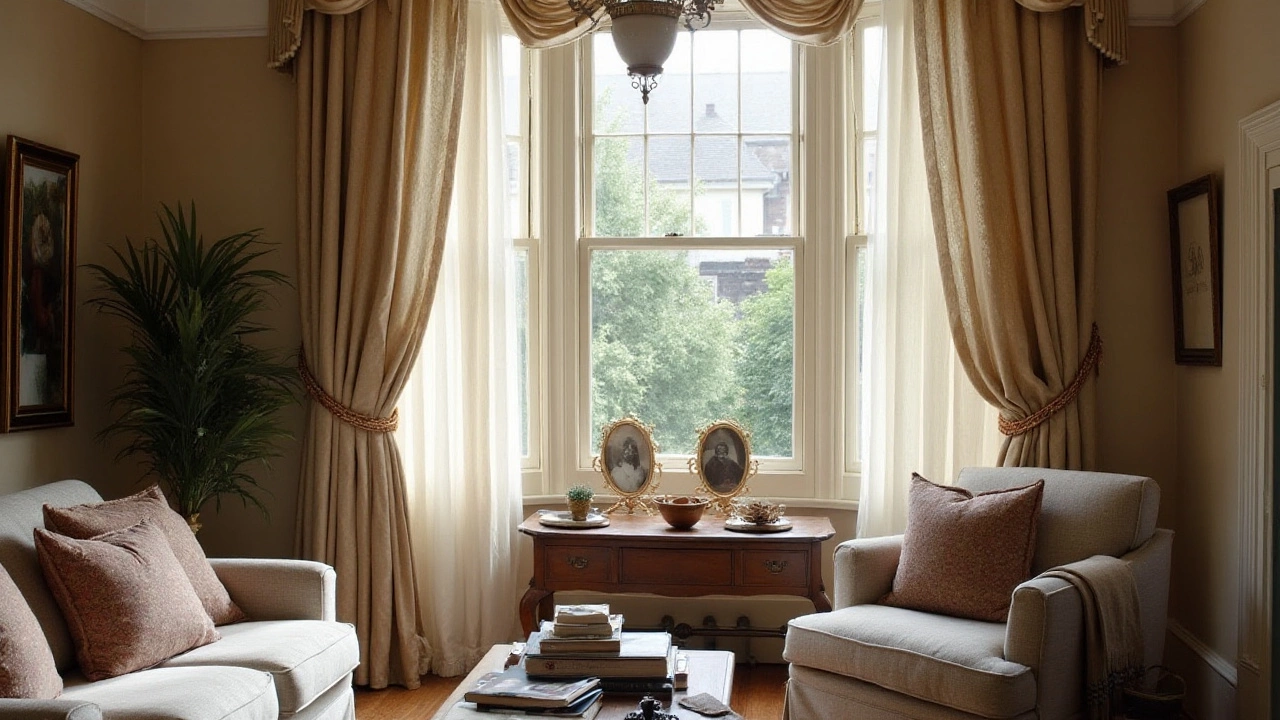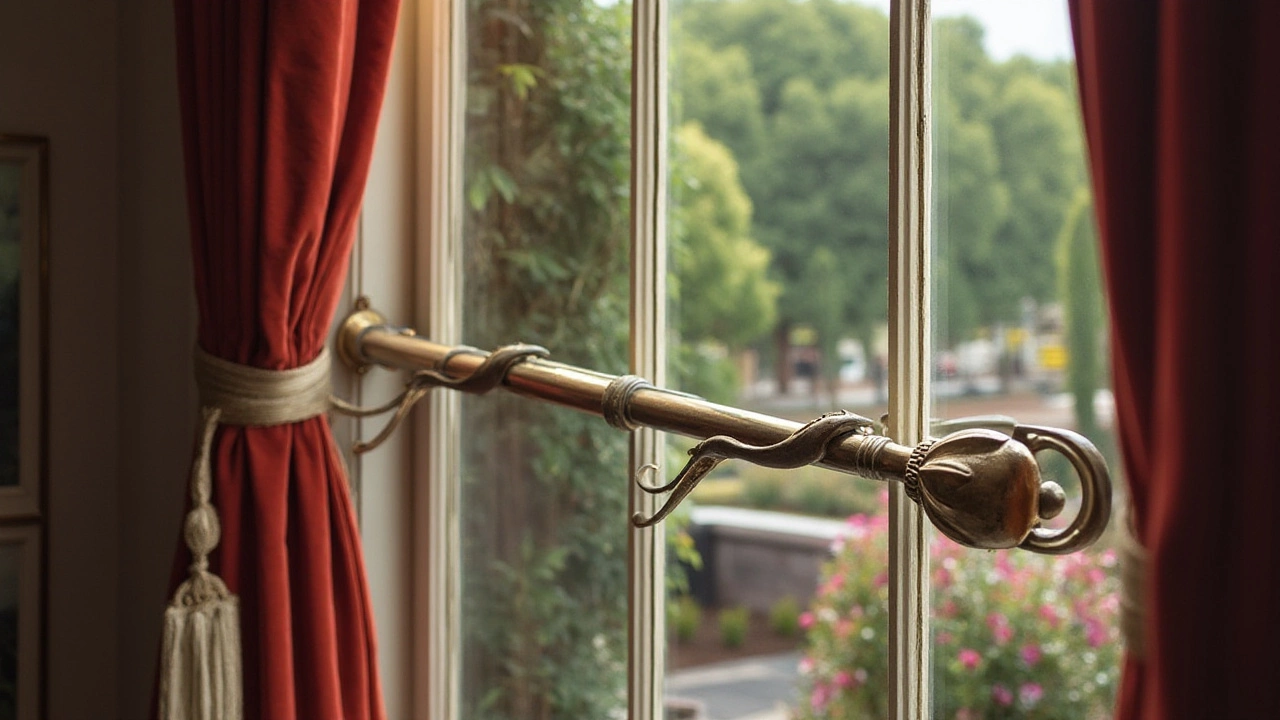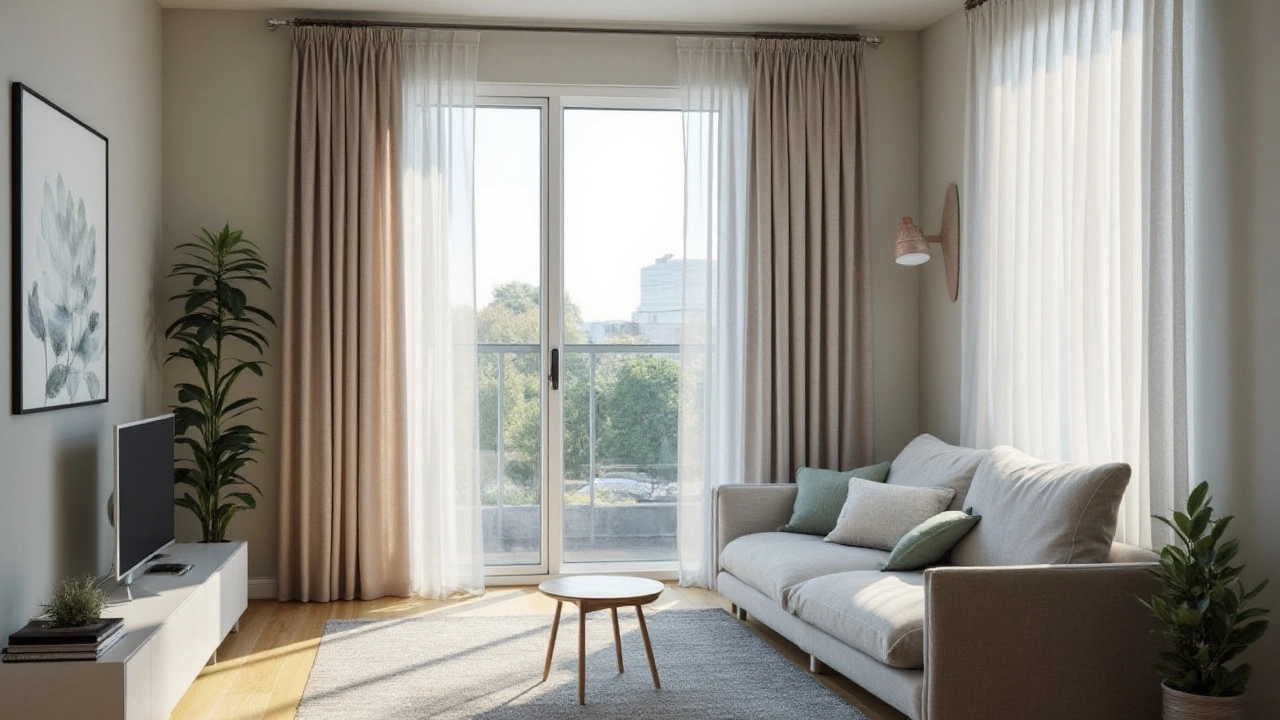Perfect Curtain Rod Extension: A Guide to Stylish Window Dressing
 Jan, 4 2025
Jan, 4 2025
When it comes to home decor, the humble curtain rod often goes unnoticed, yet it plays a crucial role in defining the aesthetic of any room. A well-placed rod not only supports your curtains physically but also sets the stage for them to become a functional and stylish feature of your living space. How far should a curtain rod extend past a window? Although it might seem like a minor detail, getting this measurement right is essential to maximizing both light control and the visual appeal of your windows.
Typically, the curtain rod should extend between 3 to 6 inches beyond the window frame on each side. This allows the curtains to stack off the glass when open, offering a full view and making the window appear larger. Additionally, this extension can prevent light from seeping in through the gaps at the sides, ensuring better privacy and insulation.
- Understanding Curtain Rod Length
- Benefits of Proper Extension
- Measuring Your Windows
- Installation Tips
- Design Considerations
Understanding Curtain Rod Length
Why does curtain rod extension matter in the grand scheme of home design? The length of a curtain rod is not just a practical measure but an invitation to redefine how your space interacts with light and scale. Traditionally, curtain rods are seen purely as a means to hang fabric, yet the savvy decorator knows that this is just scratching the surface. The correct curtain rod length extends an elegant welcome into a realm of style and substance. Attention to detail here can dramatically alter the ambiance of your living room, bedroom, or office.
When measuring your curtain rod, you must consider the entirety of your window frame and the desired impact. A rod that only spans the length of the window frame might seem logical at first, but it risks creating a boxed-in look that reduces the perception of space. Extending the rod allows curtains to hang free and clear of the frame when open. This practice is not merely aesthetic; it is grounded in the practical advantage of preserving glass visibility and maximizing natural light. Interior designers often suggest adding 3 to 6 inches on each side of the window for the perfect blend of form and function.
Architectural elements around your window—such as cornices, molding, or nearby walls—also play a role in determining curtain rod length. Without accounting for these, you might stumble into the common pitfall of visually crowding an elaborate or minimalistic room setup. A thoughtful approach to curtain rod placement offers a perspective that can seamlessly blend with pre-existing features or introduce striking contrasts. Keep in mind, rooms with high ceilings might benefit from rods placed considerably higher than the frame to draw the eye upward and accentuate verticality, creating a more grandiose appearance.
It's worth considering a quote from renowned interior designer Nate Berkus, who once said, "Your home should tell the story of who you are, and be a collection of what you love."
The length of curtain rods is seldom scrutinized, yet it has the power to narrate your aesthetic preferences—be it lavish opulence or understated elegance.Harnessing this humble feature can elevate your entire space, bridging harmony between the indoor light and your chosen drapery while providing functional benefits, such as insulating qualities and privacy control.
Adjusting curtain rod lengths can even offer an opportunity for experimentation. By experimenting with different lengths beyond the window’s edge, homeowners can find a dimension that enhances both the window and the room. This process can involve a host of other design choices, including the style of finials you select. Finials anchor the visual endpoint of the rod and are another aspect to consider, as their design should complement both the curtain style and the room’s overall decor. People often underestimate how much potential lies in such details until they see the magic that small adjustments produce.
Benefits of Proper Extension
Choosing the correct curtain rod extension does more than just hold your drapes in place; it significantly enhances the room's ambience and functionality. When a curtain rod extends adequately, about 3 to 6 inches beyond the window frame, it allows curtains to be drawn entirely off the window panes, which is crucial for several reasons. Firstly, this technique allows you to maximize natural light during the daytime, creating a brighter and more inviting space without the obstruction of fabric. The result is an illusion of larger windows and a more spacious room—a wonderful trick to employ especially in smaller areas.
Moreover, the proper extension of a curtain rod ensures much-needed privacy when the drapes are closed. By allowing curtains to fully overlap with the wall rather than just the window, you minimize the chances of any gaps that might allow prying eyes from peeking in. This approach doesn't just apply to privacy. Enhanced energy efficiency is another benefit because well-extended curtains help trap heat during winters and block heat during summers, leading to a reduced utility bill. It’s these subtle nuances that make a substantial difference in the livability of your home.
Enhanced Aesthetic and Style
Furthermore, there's the element of style to consider. A well-extended rod allows for the elegant draping of curtains, which can act as a statement piece in your decor. Many interior designers argue that the layers provided by luxuriously hanging curtains give a finished, tailored look to a space. As eloquently noted by interior design expert, Jonathan Adler:"Window treatments should always be a revelation, not an afterthought. A generous rod extension can frame your world and transform your room into a cohesive and polished retreat."Indeed, aligning the right curtain rod extension with your home’s interior theme can elevate the entire atmosphere, making your curtains not just a functional tool but an integral part of home styling.
Adequately extended curtain rods also work wonders for positioning versatility. This setup means you can easily opt for layered curtain styles—think sheer panels beneath heavier curtains—adding depth and dynamic texture to your decor. The extra space allotted by an extended rod accommodates such combinations, allowing you to play with different fabrics and patterns without crowding the window frame. This flexibility introduces vibrant possibilities to match seasonal changes or simply reflect your evolving tastes, keeping your interiors fresh and appealing year-round.

Measuring Your Windows
Embarking on the journey to find the perfect curtain rod extension begins with knowing your window measurements like the back of your hand. It's not just about width; considering height, frame depth, and even the distance from the ceiling can shape how curtains hang and how a room feels. To achieve a look that's balanced and elegant, you'll need a tape measure, some patience, and a good eye for detail. Start by measuring the width of the window from one side of the frame to the other. Extend the measurement 3 to 6 inches on each side to ensure the rod will allow the curtains to be drawn fully open without blocking too much of the window pane. This trick not only gives you maximum light but also creates a sense of expansiveness.
Next, consider the height. Curtains that hang from the ceiling to the floor naturally draw the eye upward, creating an illusion of height in the room—a handy trick for ceilings that are lower than you'd like. Measure from where the rod will be placed, typically a couple of inches above the window frame, down to the floor. Remember, pooling curtains gently on the floor can add luxury, while curtains brushing the floor offer a more tailored look. Don't forget to account for any protrusions, like window sills or radiators, which might interfere with curtain draping.
Additionally, measure the depth of the window frame, particularly if you plan to hang inside mounts or opt for casing rods that are mounted closer to the wall. For bold, dramatic styles, like blackout curtains, a deeper frame may accommodate the bulkier fabric better. 'Measure twice, cut once,' they say. Precision will go a long way in preventing unnecessary returns and exchanges. According to interior designer Emily Henderson, 'The difference between an okay room and a great one often lies in minute details like curtain placement.'
Finally, let's not overlook the style aspect. If your windows encompass unique features—such as bay styles or archways—specific measurements become essential to tailor the rod installation to these unique contours. Such challenges might mean using multiple rod brackets to shape or support the curtains correctly, ensuring an unbroken line along the top that aligns with your interior design vision. Keep in mind, personal style preferences are crucial, and a well-measured, well-hung curtain is as much about personal expression as it is about perfect proportions. So, be bold and confident, and ensure the measurements translate into a stunning showcase frame for your beautiful curtains.
Installation Tips
Installing curtain rods might seem straightforward, yet there are nuances that can significantly impact the outcome. The first step in the installation process is to gather the right tools and materials, such as a measuring tape, level, pencil, drill, and appropriate screws and anchors for your wall type. You'll want to ensure that your curtain rod can support the weight of the curtains, and this requires considering the fabric type and length. Lightweight fabrics might work well with a standard rod and mounting hardware, but heavier materials like velvet may need more robust support.
Start by identifying the exact placement of the curtain rod brackets. This involves deciding the height at which you want your curtains to hang. While the rod is typically mounted a few inches above the window frame, hanging the rod closer to the ceiling can add the illusion of height and make your room seem more spacious. When you've chosen the height, make marks where you'll drill. It's crucial to use a level to ensure these marks are aligned perfectly, resulting in an even installation.
Before attaching the brackets, you'll need to drill holes at your marked places. Keep in mind the composition of your wall, as this will determine whether you need anchors and what type. For example, drywall typically requires plastic or metal anchors to ensure a secure hold, while wood studs may not. Once the holes are ready, position the brackets and secure them with screws. Always double-check the alignment with a level before tightening them completely.
"Measure twice, cut once," is a mantra often expressed by seasoned carpenters and it applies here too—precision in measurement is key to a professional-looking outcome.
With the brackets in place, the next step is to slide your curtain rod into position. Depending on the style and weight of your curtains, you might want to fit the curtains onto the rod before securing it over the brackets. This can make the process more manageable, especially for tall windows. Enlisting a helping hand is often wise as it enables you to tackle longer curtains or heavier rods without the risk of dropping or damaging them.
Once positioned, secure the rod to the brackets, occasionally requiring small screws to prevent shifting. Take the time to adjust the curtain pleats so that they hang symmetrically and uniformly along the length of the rod. If you're opting for tiebacks, install them at a third of the total curtain height from the bottom. This proportion is often recommended by interior decorators to create an elegant drape that frames the window beautifully.
Finally, step back and admire your work. A correctly installed curtain rod does more than hold up fabric—it finishes a room, adding character and sophistication. Remember to clean up any dust from drilling and handle any adjustments needed to the curtains themselves. According to a survey by the National Association of Home Builders, nearly 75% of homeowners considered window dressing as the key feature in defining the aesthetic of their living spaces. It’s these small, diligent details that transform a house into a home.

Design Considerations
When selecting the right curtain rod placement, it's crucial to consider both functionality and aesthetics. The process is not just about securing a curtain rod but creating a balance that complements the room's overall decor. To start, consider the size and scale of your window and living space. Larger windows might benefit from curtain rods that extend eight to twelve inches on either side, offering panoramic vistas when you draw the curtains back. On the other hand, for smaller windows, a subtle extension can preserve the intimacy of a cozy room while enhancing the window's appearance. A curtain rod that extends appropriately can make or break the harmony in a space, turning an overlooked corner into a statement piece.
"Design should never say, 'Look at me.' It should always say, 'Look at this.'" — David Craib
Pay attention to the material and finish of the curtain rod as well. The choice of a curtain rod extension lends itself to the broader thematic elements of your decor. Could a sleek metallic rod bring a modern sheen to a room, or does a rustic wooden finish underscore the organic elements of a bohemian-inspired living room? The choice of material is more than mere aesthetics; it interplays with the furniture, color palette, and even the curvature of your room's architecture. Ensuring the material aligns with your style can help in maintaining a cohesive look across all decor elements. Remember, the curtain rod is as much a part of the decor ensemble as the curtains themselves, speaking through understated elegance.
Another crucial aspect is the type of curtain you plan to hang. Heavier drapes might require sturdier rods with reinforced brackets to maintain stylish curtains without sagging. Lighter fabrics can usher in delicate breezes, evoking airy atmospheres when suspended from sleek, thinner rods. Think about how the curtain style harmonizes with seasonal themes or the view outside your window. Such combinations can elevate the mundane act of drawing your curtains into a theatrical performance.
Moreover, think about the rod's color with respect to your walls and curtains. Dark rod finishes contrast beautifully with light-colored walls, creating visual depth and focal points, whereas lighter rods can blend seamlessly into white or pastel walls, giving the room a soft, gentle touch. Take note of different rod finial designs, from ornate to minimalist, which can punctuate the style of your room. Looking into these creative details allows you to tailor the spec to a level that pleases your personal taste and elevates the decor style.